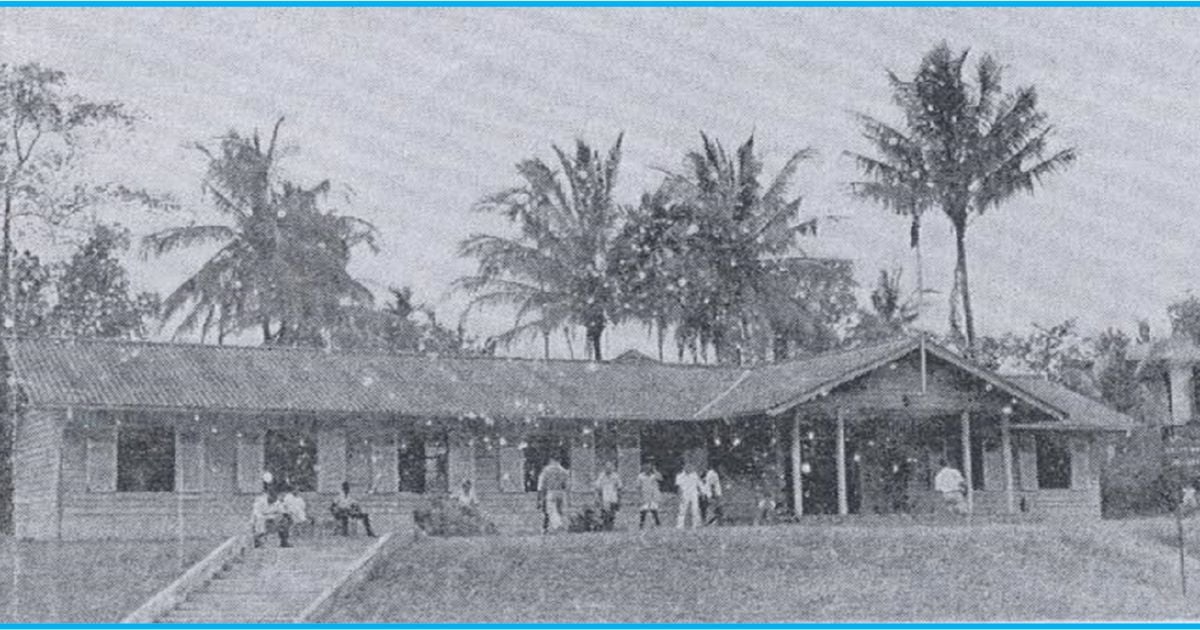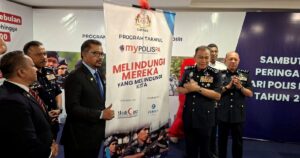IT began not in a grand hall or boardroom, but in the sterile, dimly lit confines of an anaesthetist’s room at the General Hospital in Johor Baru (now known as Hospital Sultanah Aminah).
There, in 1951, amid the quiet hum of hospital life, Dr Richard Harvey Isaacs — a newly posted anaesthetist and medical superintendent — set in motion something that would ripple far beyond the hospital walls.
A seasoned Rotarian from Kuala Lumpur, Dr Isaacs felt something missing in his new posting.
While cities like Kuala Lumpur, Melaka, Seremban and even Singapore had already planted Rotary flags as early as the late 1920s, Johor Baru remained conspicuously absent from the map.
To Dr Isaacs, that absence wasn’t just a geographical gap — it was also a missed opportunity for service, fellowship and impact.
So, from that modest corner of the then General Hospital, the Rotary Club of Johor Baru quietly took its first breath.
At the time, Malaya was in the throes of the Emergency and the recent aftermath of World War 2 had left the medical community severely understaffed.
Specialist doctors were scarce and Dr Isaacs found himself juggling multiple roles.
Despite the demands of his post, he remained committed to reviving the Rotary spirit in the south and frequently travelled to Singapore to attend Rotary meetings.
His passion culminated in a small gathering of like-minded individuals in October 1951 within his hospital office — a historic meeting that laid the foundation for the Rotary Club of Johor Baru.
With the support of the Rotary Club of Singapore, over 20 local professionals — largely comprising government officials and planters from within a 42-km radius — came together to formally establish RCJB. The club received its charter on June 27, 1952.
IMPACTFUL PRESENCE
Initially, weekly lunch meetings were held at the Johore Civil Service Club.
However, the format proved impractical due to time constraints faced by civil servants and the lengthy travel required for planters.
Despite the challenges, the club’s foundation was firmly established — marking the start of Rotary’s impactful presence in Johor.
According to Dr S. Shanmugam, the first president of the Rotary Club of Johor Baru, Dr Richard Harvey Isaacs, was installed at the historic Johore International Club located near the Royal Polo Grounds.
The ceremony, which was attended by the late Sultan Ibrahim Sultan Abu Bakar and his family, marked the beginning of a lasting royal patronage.
The club remained the venue for Rotary installations until the early 1960s.
“The Rotary Club, with the approval of Sultan Ibrahim, uniquely incorporated the state emblem and flag into its banner — a distinction believed to be unmatched by any Rotary Clubs worldwide,” shares Dr Shanmugam, a former president of RCJB.
Since its founding, RCJB has been a cornerstone of community service in the state, pioneering transformative projects that have had lasting social impact—from youth rehabilitation and literacy, to trailblazing global-firsts in healthcare.
Another former president of the club, Henry Chin recalls: “One of the club’s earliest and most meaningful contributions came in the form of the Unity Boys’ Club, a youth clubhouse constructed in the mid-1950s to rehabilitate and train ‘stray boys’ in vocational skills.”
ENDURING TIES
The initiative, he said, among the first of its kind in Johor, was completed during the presidency of Dr Richard Harvey Isaacs with strong support from fellow Rotarians.
Rotarian Tee Teong Tong undertook the building of the structure, which later had to make way for development when a bus terminal was built on the site, now opposite the present-day Amma restaurant.
Chipping in, Freddie Lee, who assumed the presidency twice in 2015 and 2020 shares: “The installation of RCJB’s first president, Dr Isaacs, was held at the Johore International Club, a historic venue located within the royal grounds of Istana Pasir Pelangi, adjacent to the Royal Polo Grounds.”
The event, he says, was marked by the presence of Sultan Ibrahim and the royal family, underlining the close ties between RCJB and Johor’s royal household — an enduring relationship that continues to this day.
In fact, the club’s early installations and key events were regularly held at the Johore International Club until the 1960s.
Henry recalls: “In a symbolic gesture of royal endorsement, the President’s Badge of Office was presented to the Club by the state, through Sultan Ibrahim, during its formative year.”
This badge, he stresses, is unique, bearing the state crest with the crescent and central star flanked by four corner stars — a distinction no other Rotary club in the world holds.
While the original badge is now preserved and worn only during official ceremonies, a replica is used for regular meetings, following a brief scare when the original was nearly lost.
PIONEERING SPIRIT
RCJB’s influence extended well beyond symbolic traditions. In 1962, under the presidency of Datuk Charles Jerome Lowe, the club established Johor Baru’s first public library, the Sultan Ismail Library, located near the General Post Office.
The library was staffed by volunteers from RCJB’s Ladies’ Group, including Datin Patricia Lim — a professional librarian from Singapore — and several American Peace Corps members.
Funded and managed entirely by the club in its early years, the library was later handed over to the State government.
The club also holds the distinction of planting the seed for youth leadership development in the region.
Under the guidance of the late past president James Ho, the concept of a Senior Interact Club for school-leavers was submitted to Rotary International, eventually leading to the formation of one of the earliest Rotaract Clubs in the world.
RCJB’s pioneering spirit in healthcare set global benchmarks.
In 1989, the club launched what’s believed to be the first Rotary Dialysis Centre in the world, addressing the needs of patients with end-stage kidney disease.
This was followed by another global first in 1992, when it established the first Rotary-run hospice care facility, offering compassionate end-of-life care to terminally ill patients.
This project brought great relief and comfort for the terminally ill cancer patients and their family. It was then called Rotary Hospice Programme.
RCJB continues to be a beacon of hope, weaving compassion into action through a multitude of community-driven initiatives that touch lives across the state.
TREASURED MILESTONES
In a world of service clubs, few can claim as many milestones as RCJB.
From rehabilitating lost youth and promoting literacy, to laying foundations in public healthcare and youth development, the Rotary Club of Johor Baru continues to live up to its legacy as a club of “firsts” — deeply rooted in tradition, yet constantly evolving to meet the needs of the present.
A new chapter in compassionate service was etched into history in 2016, when the club unveiled its second dialysis centre — a milestone no other Rotary Clubs in Malaysia had achieved.
As the only club in the nation to operate two such life-saving centres, RCJB rose to meet the growing tide of renal failure with unwavering commitment and humanity, offering hope and healing to those in need.
Among their many outreach efforts, RCJB has stepped forward to support several Old Folk Homes, not just by providing essential items, but also by initiating crucial repair works to improve the daily lives of the elderly residents.
“We believe dignity should not fade with age,” muses Lee, adding: “Ensuring a comfortable and safe environment for our seniors isn’t charity. It’s a responsibility.”
With erratic weather patterns becoming the new norm, the club recognised the need for sustainable energy solutions.
Solar panels were installed in selected children’s and aged care homes to provide clean, consistent energy, reducing dependency on costly electricity while improving comfort.
“Comfort and care should not be seasonal luxuries,” says Lee, adding: “Through solar energy, we’re giving them light — both literally and symbolically.”
SUCCESSFUL CAMPAIGNS
Education has remained a cornerstone of the club’s mission. RCJB has donated substantial funds to local schools to improve infrastructure, supply learning materials and create better learning environments for students from underserved communities.
“Our investments in schools are not just about buildings, but also about building futures,” notes Henry, one of the club’s education project leads.
Environmental stewardship is another pillar of the club’s impact. In response to the climate crisis, RCJB embarked on a tree-planting initiative aimed at restoring forest landscapes.
Says Lee: “Our aim is to restore forest ecosystems, as having more trees provides livelihood benefits, enhances biodiversity by offering sanctuary to many species and protects our shared environment. Each sapling we plant is a promise to future generations.”
Among RCJB’s many successful campaigns is the Bag 2 School project, which delivered schoolbags to primary schools struggling with limited resources.
“Many of these children come from backgrounds where even a schoolbag is a luxury. Giving them something as basic as a proper bag makes a world of difference,” shares Henry.
LASTING MARK
Over the years, the club has also generously sponsored the New Straits Times to a number of secondary schools where students were able to use it as educational resources in classrooms to enhance literacy and other skills.
“It’s a partnership between the club and schools, where free newspapers are delivered to schools. NIE programmes aim to make learning more engaging by connecting curriculum to real-world events and issues, promoting critical thinking and fostering a love of reading,” says Lee.
In the spirit of festive seasons, the club ensures that no celebration goes unnoticed among the underserved.
From Deepavali to Hari Raya, Christmas to Chinese New Year, RCJB members distribute food packs, household necessities and cheer to B40 families, single mothers and the hardcore poor.
“We may not be able to solve poverty overnight, but we can certainly bring warmth and joy,” says said Dr Shan.
On the international front, the RCJB has made a lasting mark through a deeply compassionate collaboration with the Sobbhana Women’s Foundation, led by Princess Norodom Marie.
Fifteen years ago, they began a heartfelt educational mission to uplift the lives of 25 underprivileged Cambodian children.
Since then, with unwavering dedication — interrupted only by the Covid-19 pandemic — RCJB Rotarians have made annual pilgrimages to Phnom Penh.
What started as a simple educational outreach has evolved into a powerful two-pronged mission.
A two-day dental camp was added, benefiting over 150 students and conducted in partnership with the Cambodian Dental Association.
In makeshift rural setups — far from the gleam of modern clinics — volunteer dentists and dental students deliver critical care using wooden tables, hand-held mirrors and diesel-powered generators.
“For many of these children, it’s their first encounter with a dentist,” shares Dr Shan, adding: “It’s not just a checkup — it’s a moment of transformation, of being seen, cared for and remembered.”
This enduring initiative stands as a beacon of compassion, bridging borders with empathy and action.
Since the dawn of the new millennium, RCJB has quietly yet powerfully inscribed a legacy of compassion through 15 life-changing Plastic Surgery Missions to the Philippines.
At the heart of these missions stands past president Dr Angamuthu Rajoo — the club’s very own plastic and cosmetic surgeon whose skilled hands and unwavering heart have become instruments of hope.
HIGHEST CALLING
From the vibrant streets of Manila to the humble provinces of Koronadal, Cauayan, and Iloilo City, these missions touched the lives of 262 of the most impoverished and forgotten individuals — those for whom surgical care was once a distant dream.
A total of 359 procedures were performed, with Dr Angamuthu himself conducting 225 surgeries on 155 patients.
The team restored faces and futures — repairing cleft lips and palates, releasing burn contractures, revising scars, and removing skin cancers.
Each surgery was more than a medical act; it was a profound gesture of dignity, a promise of renewed life.
Carried out in remote, underserved medical centres — often with limited equipment, minimal supplies and fragile patient conditions — these missions demanded not just skill, but also resilience and heart.
Yet, even amid hardship, the Rotary spirit triumphed.
Where tools fell short, human kindness prevailed. Where sterility was compromised, compassion became the antidote to fear.
And where pain had long taken root, smiles began to bloom once more.
These missions stand as a shining embodiment of Rotary’s highest calling. They’re not merely medical outreaches, but testaments to the motto — healing not just bodies, but spirits, bridging nations through empathy and stitching together a world woven with mercy, humanity and hope.
LEADING WITH HEART
At the heart of these efforts is an unshakable belief in the Rotary motto: Service Above Self.
Each member’s unwavering commitment is a living testament to this ideal.
“Do your little bit of good where you are. It’s those little bits of good put together that overwhelm the world,” reflects Chin, adding: “Whether it’s through extending a helping hand, speaking up for the voiceless or simply being present for someone in need, our actions ripple through the tapestry of life, leaving behind echoes of love, strength and resilience.”
As RCJB continues to lead with heart, their legacy grows — one act of kindness, one community, one hopeful heartbeat at a time.
RCJB’s building today stands tall — not merely in brick and mortar, but also as a proud symbol of legacy, service and enduring compassion.
It rises with quiet dignity, echoing decades of dedication to community upliftment and bearing witness to countless acts of kindness sown in the spirit of Rotary.
Each corner whispers stories of selfless service, each wall holds memories of milestones achieved and its foundation is rooted deeply in values that transcend time.
© New Straits Times Press (M) Bhd






